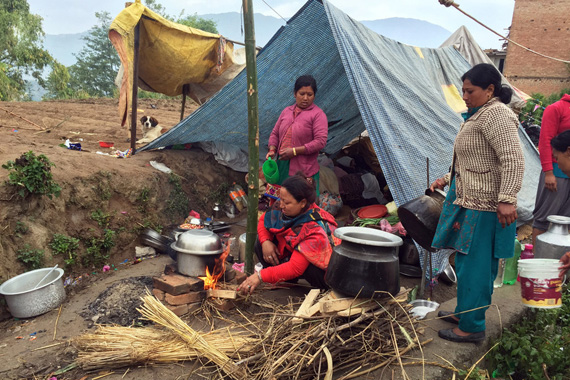A Statement from the Institute for Asian Research, University of British Columbia:
The Institute for Asian Research at UBC sends its deepest condolences to the people of Nepal in the aftermath of the 7.8 earthquake that struck the country on April 25th, 2015. UBC has many connections with Nepal, and many faculty, students, and alumni have been working hard to support relief efforts through coordination, translation, fundraising, and information sharing. For those who would like to donate to organizations engaged in relief and eventually reconstruction in Nepal, the Canadian government is matching donations made to the Red Cross until May 25th; see also the list put together by the Association of Nepal and Himalayan Studies here).
Memo #334
By Sara Shneiderman – sara.shneiderman [at] ubc.ca and Mark Turin – mark.turin [at] ubc.ca

 The full scale of the catastrophe caused by Nepal’s April 25 earthquake is becoming clearer. Currently, over 6,000 people are confirmed dead, over 10,000 injured, 8 million affected, with 3 million in need of food aid. This is still an incomplete picture: some estimates predict fatalities up to 50,000 once rural areas are fully assessed.
The full scale of the catastrophe caused by Nepal’s April 25 earthquake is becoming clearer. Currently, over 6,000 people are confirmed dead, over 10,000 injured, 8 million affected, with 3 million in need of food aid. This is still an incomplete picture: some estimates predict fatalities up to 50,000 once rural areas are fully assessed.
We have been unable to make direct contact with our closest research partners in Dolakha district since the earthquake struck. Others we know are safe, but their houses are destroyed. Entire families are sleeping outside in the rain with little access to food. Official relief efforts, if any, are few. A Dolakha-based journalist posted a message yesterday reading, “just arrived from Dolakha Kshamawati [village], 6 people died there and 900 houses, and schools, health posts collapsed.” Their story is but a tiny drop in the sea of suffering that Nepalis in the most affected districts are facing.
So what is holding up the government’s response? The long answer involves structural, infrastructural, and social factors. For the first few days after the disaster the focus of the state was exclusively on the capital city of Kathmandu, while the international media fixated on Everest rescue missions. A Facebook post from April 27 reads like a digital-era SOS: “The Nepali government is locked down in Kathmandu. Nepal and Nepalis also exist outside: in Sindhupalchok, Gorkha, Rasuwa, Dhading, and Dolakha. Send supplies immediately.” In the absence of shelter or visible aid on the horizon, some villagers in rural Nepal are reportedly considering collective out-migration. Such mass displacement would further challenge resource capability across the region.
A vast array of international, national, and local organizations, as well as individual citizens and foreigners are mobilizing every resource that they can. The UN Office of the Coordinator of Humanitarian Affairs is requesting that independent groups do not send untrained volunteers or ship supplies to Nepal—the airport is congested, as is airspace over India, and the supply chain is blocked. Their advice is to send cash to reputable organizations working on the ground (the Canadian government is matching donations made to the Red Cross until May 25th; see also the list put together by the Association of Nepal and Himalayan Studies here). On April 30, the Nepali government caused consternation by issuing a directive that all donations must be channeled through the government’s central relief fund. It remains to be seen whether they will soften their position, but for now it is causing some contributors to reconsider their strategies.
In this country ravaged first by war, and now by natural disaster, Nepal’s citizens will have a long and slow path to recovery. But transparent relief that is distributed quickly to the regions most affected, followed by careful planning and rebuilding that attends to inequalities, will be key steps on this path.
About the Authors:
Sara Shneiderman is Assistant Professor in Anthropology at the Institute of Asian Research at UBC.
Mark Turin is Associate Professor of Anthropology and Chair of the First Nations Languages Program at UBC. Both he and Sara Shneiderman have worked in rural Nepal for over 20 years.

Some of the hardest hit by the recent earthquake are poor, rural residents for whom options are few and relief far off (Credit: plan-international.org).
Links
Sara Shneiderman and Mark Turin, “Nepal’s relief effort must reach the rural poor,” Globe & Mail (April 27, 2015)
Manjushree Thapa, “The Catastrophe We All Saw Coming,” Foreign Policy (April 29, 2015)
John Bevan (Oxfam), “Political (and some other) priorities in Nepal as of 28 April 2015” (April 29, 2015)
David N. Gellner, “Could Nepal’s messy politics hamper relief efforts?” The Conversation (April 29, 2015)
Sahina Shrestha, “Langtang is gone,” Nepali Times (May 2015)
Nepali Times, “Shaking things up” (Editorial) (May 2015)
Related Memos:
See our other memos on Nepal.
[…] quake on May 12 left nearly 3 million people homeless in the Himalayan country—almost no one expected immediate help from the Nepalese government itself, including the people I spoke with in Kathmandu when I was there on May 3 and May 4. That a […]
[…] quake on May 12 left nearly 3 million people homeless in the Himalayan country—almost no one expected immediate help from the Nepalese government itself, including the people I spoke with in Kathmandu when I was there on May 3 and May 4. That a […]